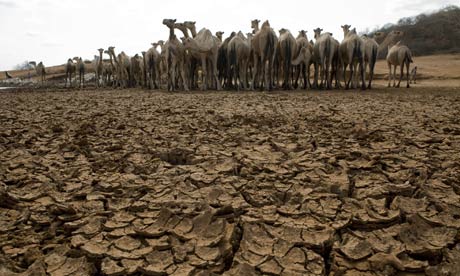Kenya drought ‘passed emergency levels months ago’
As one devastating drought follows another, the future is bleak for millions in east Africa. John Vidal reports from Moyale, Kenya 
By John Vidal We met Isaac and Abdi, Alima and Muslima last week in the bone-dry, stony land close to the Ethiopia-Kenya border. They were with five nomad families who have watched all their animals die of starvation this year in a deep drought, and who have now decided their days of herding cattle are over. After three years of disastrous rains, the families from the Borana tribe, who by custom travel thousands of miles a year in search of water and pasture, have unanimously decided to settle down. Back in April, they packed up their pots, pans and meagre belongings, deserted their mud and thatch homes at Bute and set off on their last trek, to Yaeblo, a village of near-destitute charcoal makers that has sprung up on the side of a dirt road near Moyale. Now they live in temporary “benders” – shelters made from branches covered with plastic sheeting. They look like survivors from an earthquake or a flood, but in fact these are some of the world’s first climate-change refugees. … They are not alone. Droughts have affected millions in a vast area stretching across Kenya, Somalia, Ethiopia, Eritrea, Sudan, Chad, and into Burkina Faso and Mali, and tens of thousands of nomadic herders have had to give up their animals. “[This recent drought] was the worst thing that had ever happened to us,” said Alima, 24. “The whole land is drying up. We had nothing, not even drinking water. All our cattle died and we became hopeless. It had never happened before. So we have decided to live in one place, to change our lives and to educate our children.” Kenya, a land more than twice the size of Britain, is everywhere parched. Whole towns such as Moyale with more than 10,000 people are now desperate for water. The huge public reservoir in this regional centre has been empty for months and, according to Molu Duka Sora, local director of the government’s Arid Lands programme, all the major boreholes in the vast semi-desert area are failing one by one. Earlier this year, more than 50 people died of cholera in Moyale. It is widely believed that it came from animals and humans sharing ever scarcer water. Food prices have doubled across Kenya. A 20-litre jerrycan of poor quality water has quadrupled in price. Big game is dying in large numbers in national parks, and electricity has had to be rationed, affecting petrol and food supplies. For the first time in generations there are cows on the streets of Nairobi as nomads like Isaac come to the suburbs with their herds to feed on the verges of roads. Violence has increased around the country as people go hungry. “The scarcity of water is becoming a nightmare. Rivers are drying up, and the way temperatures are changing we are likely to get into more problems,” said Professor Richard Odingo, the Kenyan vice-chair of the UN’s Intergovernmental Panel on Climate Change (IPCC). “We passed emergency levels months ago,” said Yves Horent, a European commission humanitarian officer in Nairobi. “Some families have had no crops in nearly seven years. People are trying to adapt but the nomads know they are in trouble.”